Contemporary Indigenous Health and Wellbeing Guided Reflection Report
VerifiedAdded on 2022/10/17
|7
|1699
|11
Report
AI Summary
This report presents a guided reflection on contemporary Indigenous health and wellbeing, examining the student's evolving understanding of Aboriginal and Torres Strait Islander health issues. Utilizing Gibbs' reflective framework and the ABCD cultural assessment tool, the student describes their changing perceptions of discrimination, cultural beliefs, and the impact of government initiatives. The reflection incorporates three learning activities, highlighting the importance of cultural sensitivity, effective communication, and equal treatment in healthcare. The student evaluates the impact of the subject on their future nursing practice, emphasizing the need for culturally appropriate care, ethical decision-making, and collaboration with Indigenous communities. The report concludes with an action plan for implementing these learnings, emphasizing the role of nurses in promoting health and well-being for Indigenous Australians. The student also incorporates reference to the Registered nurse standards for practice and the guide to appropriate Aboriginal terminology.
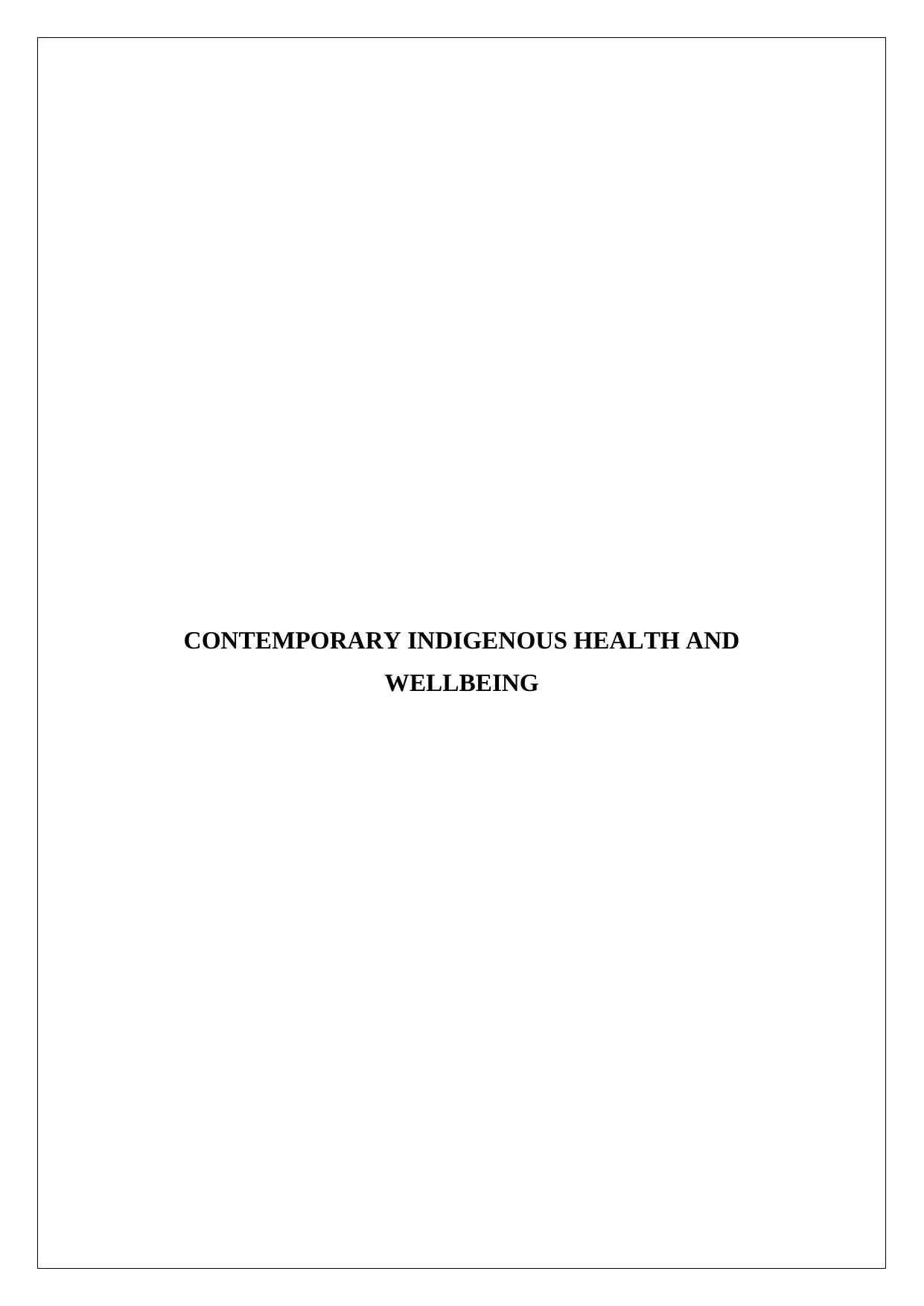
CONTEMPORARY INDIGENOUS HEALTH AND
WELLBEING
WELLBEING
Paraphrase This Document
Need a fresh take? Get an instant paraphrase of this document with our AI Paraphraser
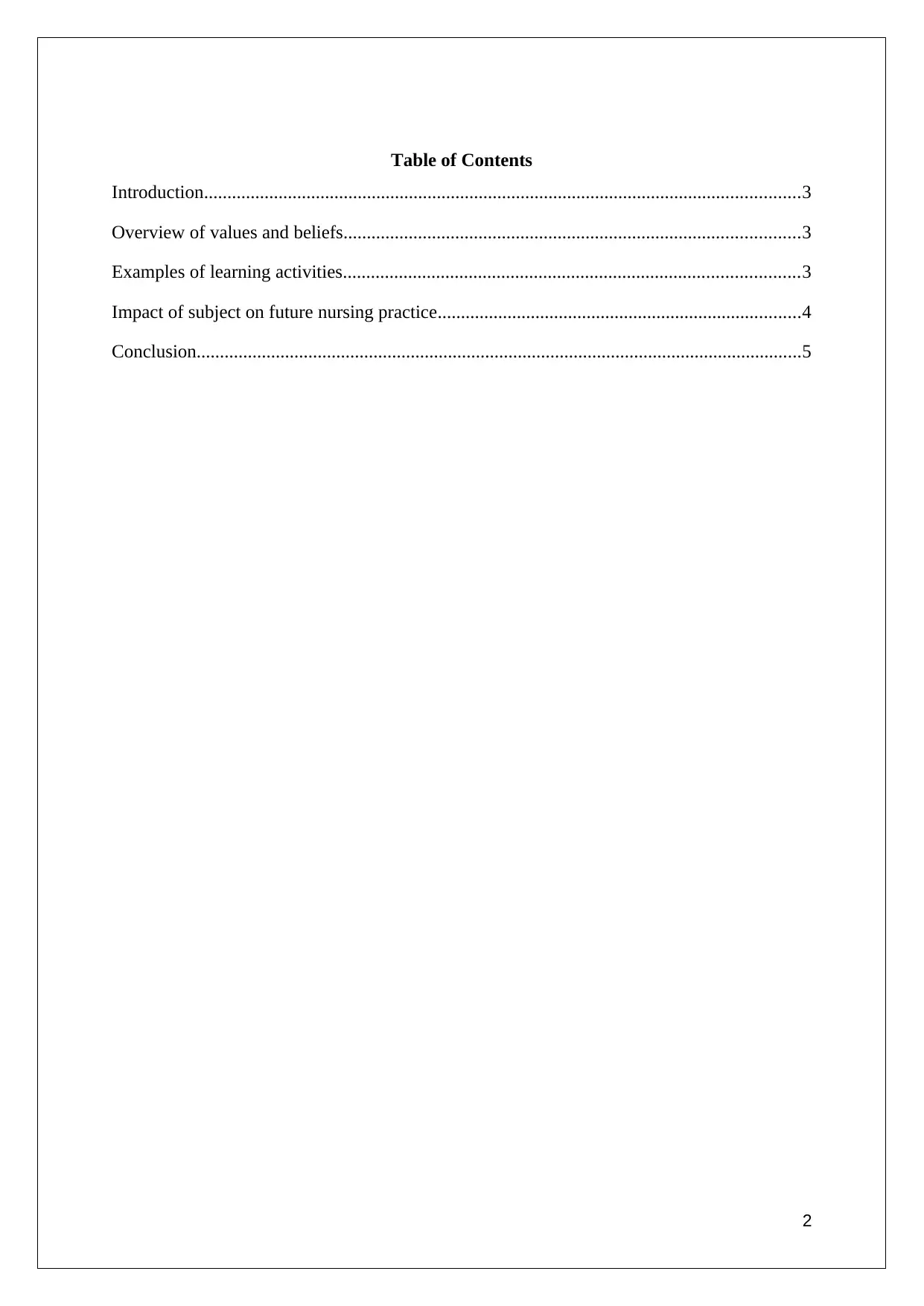
Table of Contents
Introduction................................................................................................................................3
Overview of values and beliefs..................................................................................................3
Examples of learning activities..................................................................................................3
Impact of subject on future nursing practice..............................................................................4
Conclusion..................................................................................................................................5
2
Introduction................................................................................................................................3
Overview of values and beliefs..................................................................................................3
Examples of learning activities..................................................................................................3
Impact of subject on future nursing practice..............................................................................4
Conclusion..................................................................................................................................5
2
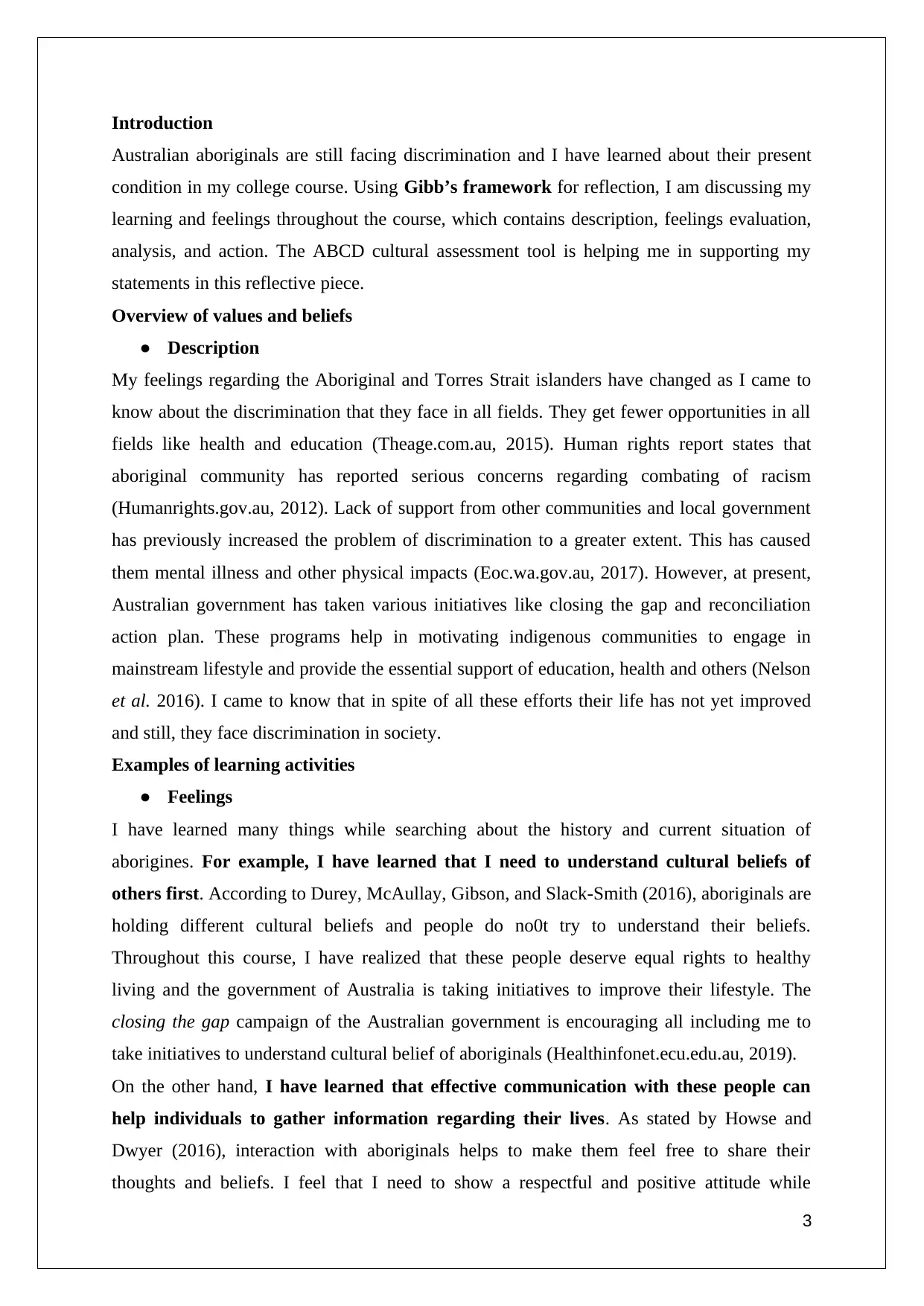
Introduction
Australian aboriginals are still facing discrimination and I have learned about their present
condition in my college course. Using Gibb’s framework for reflection, I am discussing my
learning and feelings throughout the course, which contains description, feelings evaluation,
analysis, and action. The ABCD cultural assessment tool is helping me in supporting my
statements in this reflective piece.
Overview of values and beliefs
● Description
My feelings regarding the Aboriginal and Torres Strait islanders have changed as I came to
know about the discrimination that they face in all fields. They get fewer opportunities in all
fields like health and education (Theage.com.au, 2015). Human rights report states that
aboriginal community has reported serious concerns regarding combating of racism
(Humanrights.gov.au, 2012). Lack of support from other communities and local government
has previously increased the problem of discrimination to a greater extent. This has caused
them mental illness and other physical impacts (Eoc.wa.gov.au, 2017). However, at present,
Australian government has taken various initiatives like closing the gap and reconciliation
action plan. These programs help in motivating indigenous communities to engage in
mainstream lifestyle and provide the essential support of education, health and others (Nelson
et al. 2016). I came to know that in spite of all these efforts their life has not yet improved
and still, they face discrimination in society.
Examples of learning activities
● Feelings
I have learned many things while searching about the history and current situation of
aborigines. For example, I have learned that I need to understand cultural beliefs of
others first. According to Durey, McAullay, Gibson, and Slack-Smith (2016), aboriginals are
holding different cultural beliefs and people do no0t try to understand their beliefs.
Throughout this course, I have realized that these people deserve equal rights to healthy
living and the government of Australia is taking initiatives to improve their lifestyle. The
closing the gap campaign of the Australian government is encouraging all including me to
take initiatives to understand cultural belief of aboriginals (Healthinfonet.ecu.edu.au, 2019).
On the other hand, I have learned that effective communication with these people can
help individuals to gather information regarding their lives. As stated by Howse and
Dwyer (2016), interaction with aboriginals helps to make them feel free to share their
thoughts and beliefs. I feel that I need to show a respectful and positive attitude while
3
Australian aboriginals are still facing discrimination and I have learned about their present
condition in my college course. Using Gibb’s framework for reflection, I am discussing my
learning and feelings throughout the course, which contains description, feelings evaluation,
analysis, and action. The ABCD cultural assessment tool is helping me in supporting my
statements in this reflective piece.
Overview of values and beliefs
● Description
My feelings regarding the Aboriginal and Torres Strait islanders have changed as I came to
know about the discrimination that they face in all fields. They get fewer opportunities in all
fields like health and education (Theage.com.au, 2015). Human rights report states that
aboriginal community has reported serious concerns regarding combating of racism
(Humanrights.gov.au, 2012). Lack of support from other communities and local government
has previously increased the problem of discrimination to a greater extent. This has caused
them mental illness and other physical impacts (Eoc.wa.gov.au, 2017). However, at present,
Australian government has taken various initiatives like closing the gap and reconciliation
action plan. These programs help in motivating indigenous communities to engage in
mainstream lifestyle and provide the essential support of education, health and others (Nelson
et al. 2016). I came to know that in spite of all these efforts their life has not yet improved
and still, they face discrimination in society.
Examples of learning activities
● Feelings
I have learned many things while searching about the history and current situation of
aborigines. For example, I have learned that I need to understand cultural beliefs of
others first. According to Durey, McAullay, Gibson, and Slack-Smith (2016), aboriginals are
holding different cultural beliefs and people do no0t try to understand their beliefs.
Throughout this course, I have realized that these people deserve equal rights to healthy
living and the government of Australia is taking initiatives to improve their lifestyle. The
closing the gap campaign of the Australian government is encouraging all including me to
take initiatives to understand cultural belief of aboriginals (Healthinfonet.ecu.edu.au, 2019).
On the other hand, I have learned that effective communication with these people can
help individuals to gather information regarding their lives. As stated by Howse and
Dwyer (2016), interaction with aboriginals helps to make them feel free to share their
thoughts and beliefs. I feel that I need to show a respectful and positive attitude while
3
⊘ This is a preview!⊘
Do you want full access?
Subscribe today to unlock all pages.

Trusted by 1+ million students worldwide
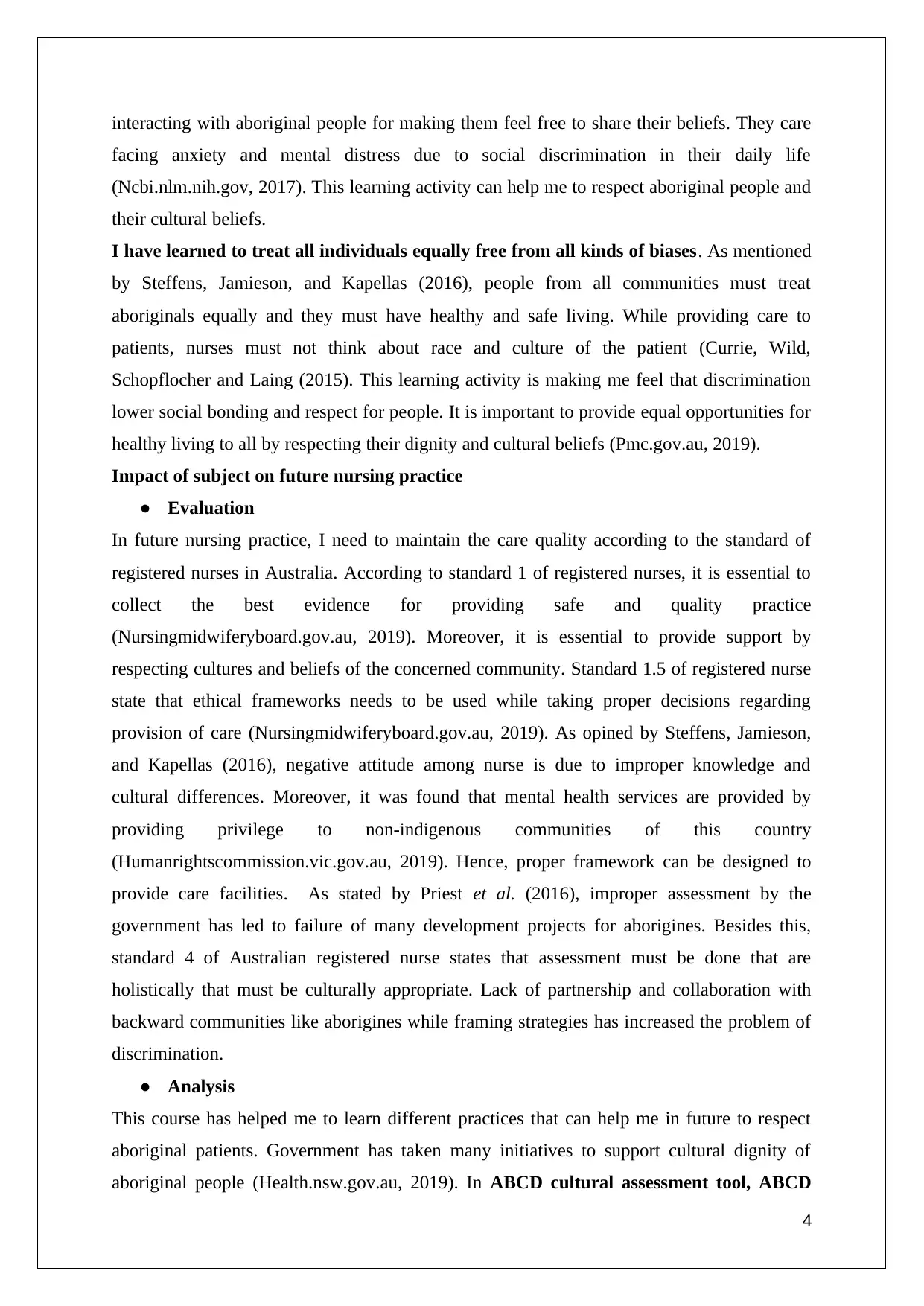
interacting with aboriginal people for making them feel free to share their beliefs. They care
facing anxiety and mental distress due to social discrimination in their daily life
(Ncbi.nlm.nih.gov, 2017). This learning activity can help me to respect aboriginal people and
their cultural beliefs.
I have learned to treat all individuals equally free from all kinds of biases. As mentioned
by Steffens, Jamieson, and Kapellas (2016), people from all communities must treat
aboriginals equally and they must have healthy and safe living. While providing care to
patients, nurses must not think about race and culture of the patient (Currie, Wild,
Schopflocher and Laing (2015). This learning activity is making me feel that discrimination
lower social bonding and respect for people. It is important to provide equal opportunities for
healthy living to all by respecting their dignity and cultural beliefs (Pmc.gov.au, 2019).
Impact of subject on future nursing practice
● Evaluation
In future nursing practice, I need to maintain the care quality according to the standard of
registered nurses in Australia. According to standard 1 of registered nurses, it is essential to
collect the best evidence for providing safe and quality practice
(Nursingmidwiferyboard.gov.au, 2019). Moreover, it is essential to provide support by
respecting cultures and beliefs of the concerned community. Standard 1.5 of registered nurse
state that ethical frameworks needs to be used while taking proper decisions regarding
provision of care (Nursingmidwiferyboard.gov.au, 2019). As opined by Steffens, Jamieson,
and Kapellas (2016), negative attitude among nurse is due to improper knowledge and
cultural differences. Moreover, it was found that mental health services are provided by
providing privilege to non-indigenous communities of this country
(Humanrightscommission.vic.gov.au, 2019). Hence, proper framework can be designed to
provide care facilities. As stated by Priest et al. (2016), improper assessment by the
government has led to failure of many development projects for aborigines. Besides this,
standard 4 of Australian registered nurse states that assessment must be done that are
holistically that must be culturally appropriate. Lack of partnership and collaboration with
backward communities like aborigines while framing strategies has increased the problem of
discrimination.
● Analysis
This course has helped me to learn different practices that can help me in future to respect
aboriginal patients. Government has taken many initiatives to support cultural dignity of
aboriginal people (Health.nsw.gov.au, 2019). In ABCD cultural assessment tool, ABCD
4
facing anxiety and mental distress due to social discrimination in their daily life
(Ncbi.nlm.nih.gov, 2017). This learning activity can help me to respect aboriginal people and
their cultural beliefs.
I have learned to treat all individuals equally free from all kinds of biases. As mentioned
by Steffens, Jamieson, and Kapellas (2016), people from all communities must treat
aboriginals equally and they must have healthy and safe living. While providing care to
patients, nurses must not think about race and culture of the patient (Currie, Wild,
Schopflocher and Laing (2015). This learning activity is making me feel that discrimination
lower social bonding and respect for people. It is important to provide equal opportunities for
healthy living to all by respecting their dignity and cultural beliefs (Pmc.gov.au, 2019).
Impact of subject on future nursing practice
● Evaluation
In future nursing practice, I need to maintain the care quality according to the standard of
registered nurses in Australia. According to standard 1 of registered nurses, it is essential to
collect the best evidence for providing safe and quality practice
(Nursingmidwiferyboard.gov.au, 2019). Moreover, it is essential to provide support by
respecting cultures and beliefs of the concerned community. Standard 1.5 of registered nurse
state that ethical frameworks needs to be used while taking proper decisions regarding
provision of care (Nursingmidwiferyboard.gov.au, 2019). As opined by Steffens, Jamieson,
and Kapellas (2016), negative attitude among nurse is due to improper knowledge and
cultural differences. Moreover, it was found that mental health services are provided by
providing privilege to non-indigenous communities of this country
(Humanrightscommission.vic.gov.au, 2019). Hence, proper framework can be designed to
provide care facilities. As stated by Priest et al. (2016), improper assessment by the
government has led to failure of many development projects for aborigines. Besides this,
standard 4 of Australian registered nurse states that assessment must be done that are
holistically that must be culturally appropriate. Lack of partnership and collaboration with
backward communities like aborigines while framing strategies has increased the problem of
discrimination.
● Analysis
This course has helped me to learn different practices that can help me in future to respect
aboriginal patients. Government has taken many initiatives to support cultural dignity of
aboriginal people (Health.nsw.gov.au, 2019). In ABCD cultural assessment tool, ABCD
4
Paraphrase This Document
Need a fresh take? Get an instant paraphrase of this document with our AI Paraphraser
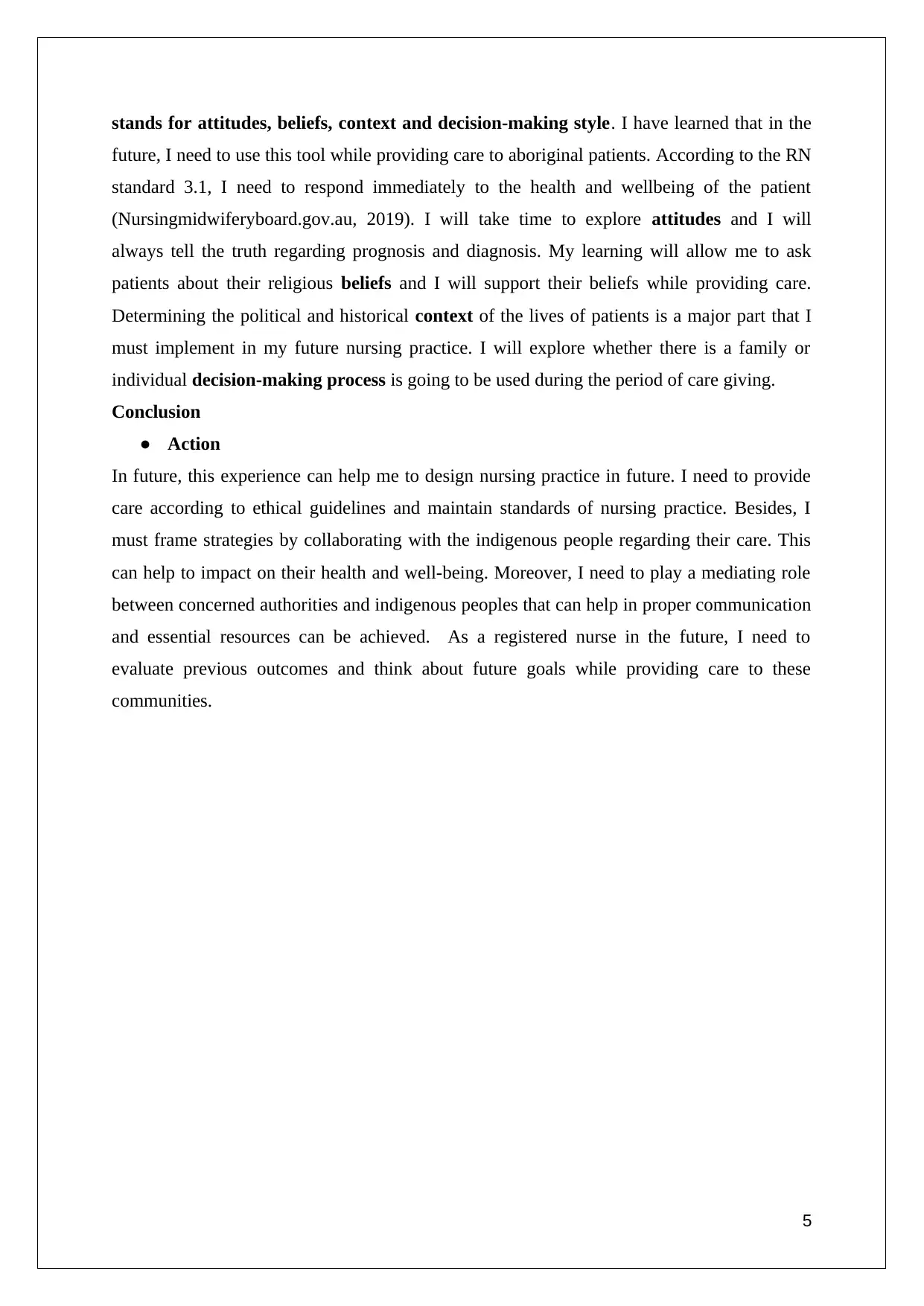
stands for attitudes, beliefs, context and decision-making style. I have learned that in the
future, I need to use this tool while providing care to aboriginal patients. According to the RN
standard 3.1, I need to respond immediately to the health and wellbeing of the patient
(Nursingmidwiferyboard.gov.au, 2019). I will take time to explore attitudes and I will
always tell the truth regarding prognosis and diagnosis. My learning will allow me to ask
patients about their religious beliefs and I will support their beliefs while providing care.
Determining the political and historical context of the lives of patients is a major part that I
must implement in my future nursing practice. I will explore whether there is a family or
individual decision-making process is going to be used during the period of care giving.
Conclusion
● Action
In future, this experience can help me to design nursing practice in future. I need to provide
care according to ethical guidelines and maintain standards of nursing practice. Besides, I
must frame strategies by collaborating with the indigenous people regarding their care. This
can help to impact on their health and well-being. Moreover, I need to play a mediating role
between concerned authorities and indigenous peoples that can help in proper communication
and essential resources can be achieved. As a registered nurse in the future, I need to
evaluate previous outcomes and think about future goals while providing care to these
communities.
5
future, I need to use this tool while providing care to aboriginal patients. According to the RN
standard 3.1, I need to respond immediately to the health and wellbeing of the patient
(Nursingmidwiferyboard.gov.au, 2019). I will take time to explore attitudes and I will
always tell the truth regarding prognosis and diagnosis. My learning will allow me to ask
patients about their religious beliefs and I will support their beliefs while providing care.
Determining the political and historical context of the lives of patients is a major part that I
must implement in my future nursing practice. I will explore whether there is a family or
individual decision-making process is going to be used during the period of care giving.
Conclusion
● Action
In future, this experience can help me to design nursing practice in future. I need to provide
care according to ethical guidelines and maintain standards of nursing practice. Besides, I
must frame strategies by collaborating with the indigenous people regarding their care. This
can help to impact on their health and well-being. Moreover, I need to play a mediating role
between concerned authorities and indigenous peoples that can help in proper communication
and essential resources can be achieved. As a registered nurse in the future, I need to
evaluate previous outcomes and think about future goals while providing care to these
communities.
5
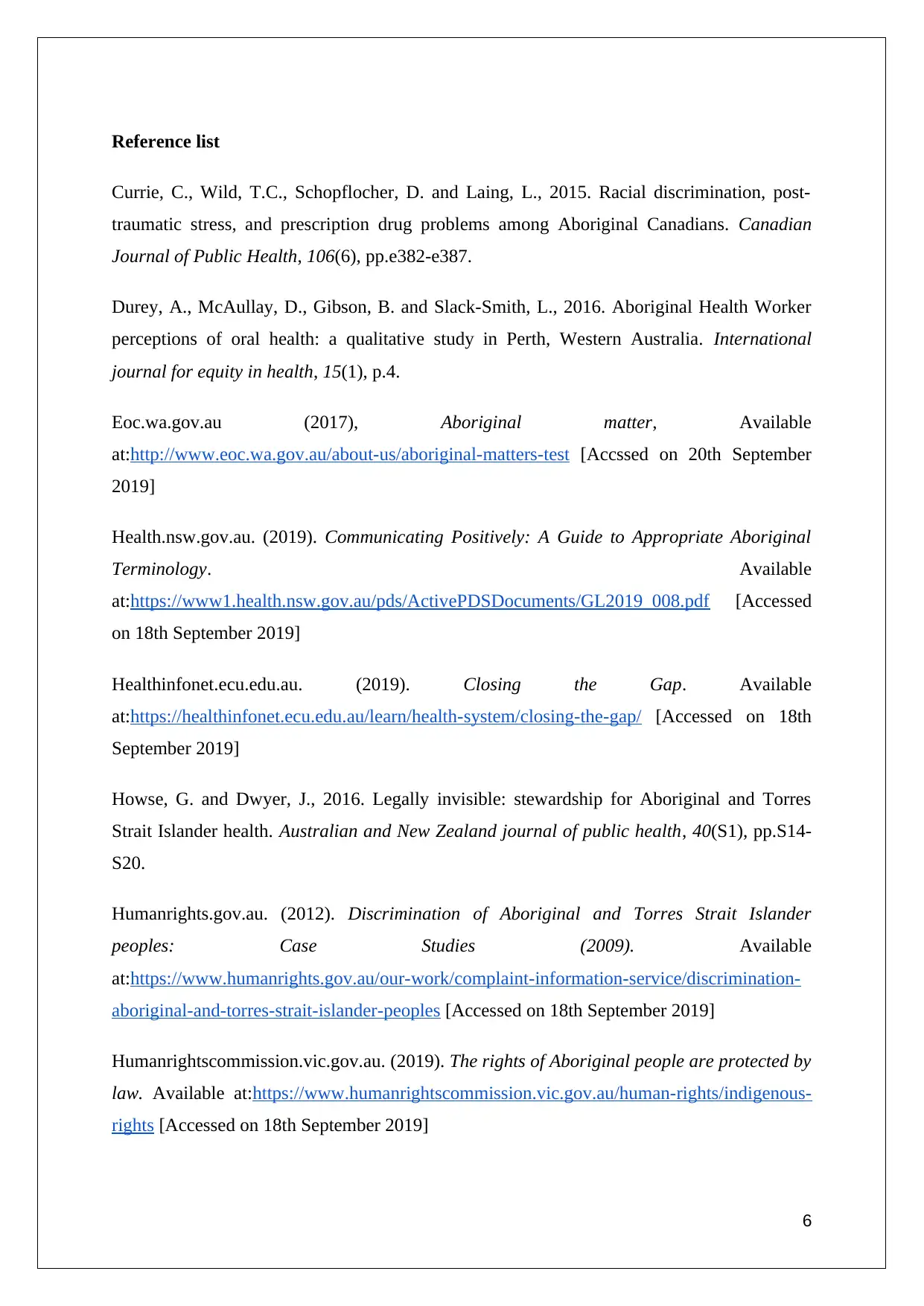
Reference list
Currie, C., Wild, T.C., Schopflocher, D. and Laing, L., 2015. Racial discrimination, post-
traumatic stress, and prescription drug problems among Aboriginal Canadians. Canadian
Journal of Public Health, 106(6), pp.e382-e387.
Durey, A., McAullay, D., Gibson, B. and Slack-Smith, L., 2016. Aboriginal Health Worker
perceptions of oral health: a qualitative study in Perth, Western Australia. International
journal for equity in health, 15(1), p.4.
Eoc.wa.gov.au (2017), Aboriginal matter, Available
at:http://www.eoc.wa.gov.au/about-us/aboriginal-matters-test [Accssed on 20th September
2019]
Health.nsw.gov.au. (2019). Communicating Positively: A Guide to Appropriate Aboriginal
Terminology. Available
at:https://www1.health.nsw.gov.au/pds/ActivePDSDocuments/GL2019_008.pdf [Accessed
on 18th September 2019]
Healthinfonet.ecu.edu.au. (2019). Closing the Gap. Available
at:https://healthinfonet.ecu.edu.au/learn/health-system/closing-the-gap/ [Accessed on 18th
September 2019]
Howse, G. and Dwyer, J., 2016. Legally invisible: stewardship for Aboriginal and Torres
Strait Islander health. Australian and New Zealand journal of public health, 40(S1), pp.S14-
S20.
Humanrights.gov.au. (2012). Discrimination of Aboriginal and Torres Strait Islander
peoples: Case Studies (2009). Available
at:https://www.humanrights.gov.au/our-work/complaint-information-service/discrimination-
aboriginal-and-torres-strait-islander-peoples [Accessed on 18th September 2019]
Humanrightscommission.vic.gov.au. (2019). The rights of Aboriginal people are protected by
law. Available at:https://www.humanrightscommission.vic.gov.au/human-rights/indigenous-
rights [Accessed on 18th September 2019]
6
Currie, C., Wild, T.C., Schopflocher, D. and Laing, L., 2015. Racial discrimination, post-
traumatic stress, and prescription drug problems among Aboriginal Canadians. Canadian
Journal of Public Health, 106(6), pp.e382-e387.
Durey, A., McAullay, D., Gibson, B. and Slack-Smith, L., 2016. Aboriginal Health Worker
perceptions of oral health: a qualitative study in Perth, Western Australia. International
journal for equity in health, 15(1), p.4.
Eoc.wa.gov.au (2017), Aboriginal matter, Available
at:http://www.eoc.wa.gov.au/about-us/aboriginal-matters-test [Accssed on 20th September
2019]
Health.nsw.gov.au. (2019). Communicating Positively: A Guide to Appropriate Aboriginal
Terminology. Available
at:https://www1.health.nsw.gov.au/pds/ActivePDSDocuments/GL2019_008.pdf [Accessed
on 18th September 2019]
Healthinfonet.ecu.edu.au. (2019). Closing the Gap. Available
at:https://healthinfonet.ecu.edu.au/learn/health-system/closing-the-gap/ [Accessed on 18th
September 2019]
Howse, G. and Dwyer, J., 2016. Legally invisible: stewardship for Aboriginal and Torres
Strait Islander health. Australian and New Zealand journal of public health, 40(S1), pp.S14-
S20.
Humanrights.gov.au. (2012). Discrimination of Aboriginal and Torres Strait Islander
peoples: Case Studies (2009). Available
at:https://www.humanrights.gov.au/our-work/complaint-information-service/discrimination-
aboriginal-and-torres-strait-islander-peoples [Accessed on 18th September 2019]
Humanrightscommission.vic.gov.au. (2019). The rights of Aboriginal people are protected by
law. Available at:https://www.humanrightscommission.vic.gov.au/human-rights/indigenous-
rights [Accessed on 18th September 2019]
6
⊘ This is a preview!⊘
Do you want full access?
Subscribe today to unlock all pages.

Trusted by 1+ million students worldwide
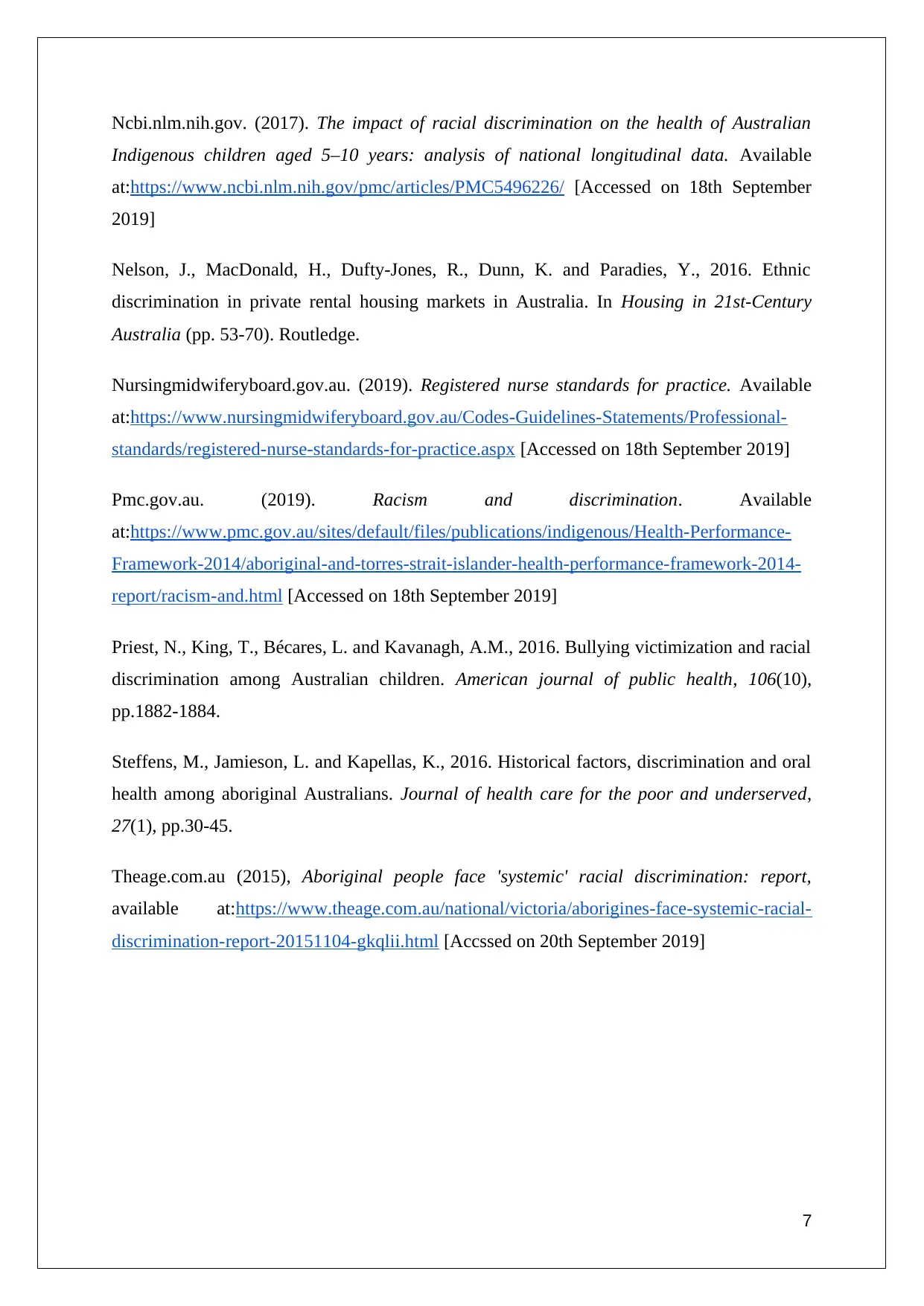
Ncbi.nlm.nih.gov. (2017). The impact of racial discrimination on the health of Australian
Indigenous children aged 5–10 years: analysis of national longitudinal data. Available
at:https://www.ncbi.nlm.nih.gov/pmc/articles/PMC5496226/ [Accessed on 18th September
2019]
Nelson, J., MacDonald, H., Dufty-Jones, R., Dunn, K. and Paradies, Y., 2016. Ethnic
discrimination in private rental housing markets in Australia. In Housing in 21st-Century
Australia (pp. 53-70). Routledge.
Nursingmidwiferyboard.gov.au. (2019). Registered nurse standards for practice. Available
at:https://www.nursingmidwiferyboard.gov.au/Codes-Guidelines-Statements/Professional-
standards/registered-nurse-standards-for-practice.aspx [Accessed on 18th September 2019]
Pmc.gov.au. (2019). Racism and discrimination. Available
at:https://www.pmc.gov.au/sites/default/files/publications/indigenous/Health-Performance-
Framework-2014/aboriginal-and-torres-strait-islander-health-performance-framework-2014-
report/racism-and.html [Accessed on 18th September 2019]
Priest, N., King, T., Bécares, L. and Kavanagh, A.M., 2016. Bullying victimization and racial
discrimination among Australian children. American journal of public health, 106(10),
pp.1882-1884.
Steffens, M., Jamieson, L. and Kapellas, K., 2016. Historical factors, discrimination and oral
health among aboriginal Australians. Journal of health care for the poor and underserved,
27(1), pp.30-45.
Theage.com.au (2015), Aboriginal people face 'systemic' racial discrimination: report,
available at:https://www.theage.com.au/national/victoria/aborigines-face-systemic-racial-
discrimination-report-20151104-gkqlii.html [Accssed on 20th September 2019]
7
Indigenous children aged 5–10 years: analysis of national longitudinal data. Available
at:https://www.ncbi.nlm.nih.gov/pmc/articles/PMC5496226/ [Accessed on 18th September
2019]
Nelson, J., MacDonald, H., Dufty-Jones, R., Dunn, K. and Paradies, Y., 2016. Ethnic
discrimination in private rental housing markets in Australia. In Housing in 21st-Century
Australia (pp. 53-70). Routledge.
Nursingmidwiferyboard.gov.au. (2019). Registered nurse standards for practice. Available
at:https://www.nursingmidwiferyboard.gov.au/Codes-Guidelines-Statements/Professional-
standards/registered-nurse-standards-for-practice.aspx [Accessed on 18th September 2019]
Pmc.gov.au. (2019). Racism and discrimination. Available
at:https://www.pmc.gov.au/sites/default/files/publications/indigenous/Health-Performance-
Framework-2014/aboriginal-and-torres-strait-islander-health-performance-framework-2014-
report/racism-and.html [Accessed on 18th September 2019]
Priest, N., King, T., Bécares, L. and Kavanagh, A.M., 2016. Bullying victimization and racial
discrimination among Australian children. American journal of public health, 106(10),
pp.1882-1884.
Steffens, M., Jamieson, L. and Kapellas, K., 2016. Historical factors, discrimination and oral
health among aboriginal Australians. Journal of health care for the poor and underserved,
27(1), pp.30-45.
Theage.com.au (2015), Aboriginal people face 'systemic' racial discrimination: report,
available at:https://www.theage.com.au/national/victoria/aborigines-face-systemic-racial-
discrimination-report-20151104-gkqlii.html [Accssed on 20th September 2019]
7
1 out of 7
Related Documents
Your All-in-One AI-Powered Toolkit for Academic Success.
+13062052269
info@desklib.com
Available 24*7 on WhatsApp / Email
![[object Object]](/_next/static/media/star-bottom.7253800d.svg)
Unlock your academic potential
Copyright © 2020–2025 A2Z Services. All Rights Reserved. Developed and managed by ZUCOL.





